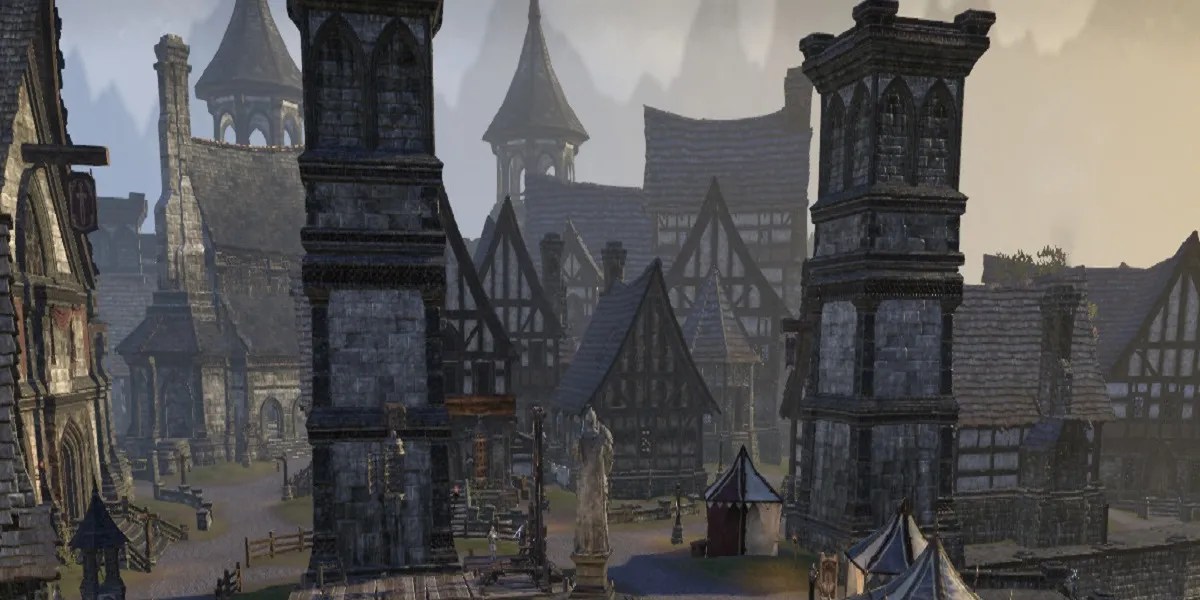EveryElder Scrollsgame has its own standout city: a place that sticks in your memory long after the main quest fades. Whether it’s for the towering architecture, bizarre NPCs, or the time you got arrested for accidentally punching a guard (we’ve all been there), each entry has that one city that feels alive.
After hundreds of hours wandering Tamriel, I’ve picked the best city from every mainline Elder Scrolls game, not based on size or lore alone, but how much it actually feels likea place you’d want to explore or live in(or accidentally set on fire).

Most cities in Daggerfall feel like randomized grids of shops and homes, but Wayrest has an actual identity. It’s a royal capital filled with political intrigue and a touch of medieval glamor. While the visuals are dated and the city’s layout can be disorienting, Wayrest still feels more alive than most places in the game.
There’s a sense that history has unfolded here, even if the mechanics don’t always make that clear. Getting lost in its sprawling streets becomes part of the charm, especially once you start unraveling the web of nobles and hidden agendas.

Vivec City is unlike anything else in the Elder Scrolls series. Suspended over water and made up of massive, tiered cantons, it’s a city designed for a god, and it shows. The layout is notoriously confusing, with identical interiors and awkward navigation, but once you learn its rhythms, it starts to make a strange kind of sense.
It’s not always user-friendly, but that’s part of what makes it so memorable. Vivec isn’t just a place on the map; it’s a strange monument to power and structure that dares you to try and make sense of it.

Chorrol doesn’t go for flash. Tucked into the wooded hills of Cyrodiil, it feels grounded, peaceful, and refreshingly normal. Its architecture leans medieval, its streets are clean and well-organized, and it serves as a perfect home base for players looking to escape the chaos of the main quest.
What makes Chorrol special isn’t complexity, it’s comfort. The people are welcoming, the Fighters and Mages Guilds are conveniently located, and it’s the kind of town where your character might actually want to settle down after a long dungeon crawl. It’s cozy in a way few fantasy cities manage to be.

Markarth is breathtaking at first glance. Built into the ruins of an ancient Dwemer city, its stone terraces and waterfalls make it one of the most visually striking locations in Skyrim. But behind the beauty is constant unease: corrupt guards, Forsworn plots, and political instability that bleeds into nearly every quest.
Navigating the city’s vertical layers can be confusing, but it fits the story: Markarth is beautiful, but broken. It’s a place where ancient history and present-day violence collide, making every visit feel like you’re stepping into something much deeper than theusual fantasy town.

Balmora
Morrowind
Balmora strikes the perfect balance between alien and familiar. Nestled in the hills of Vvardenfell, it’s a place where you can imagine your character genuinely living, running errands, and slowly rising through the ranks of House Hlaalu.
The Silt Strider towers at the edge of town remind you you’re not in Cyrodiil anymore, but the adobe buildings and winding river make it feel approachable. Unlike Vivec, Balmora is easy to navigate. It has personality without overwhelming you, and it quickly becomes home base for most players, even if it doesn’t try too hard to impress.

Anvil
Oblivion
Anvil feels like a break from everything else in Oblivion. It’s warmer and more relaxed than the other cities, thanks to its coastal setting and coral-colored stonework. The harbor’s always bustling, and there’s a subtle pirate vibe if you know where to look.
But Anvil also hides some of the game’s best surprises, like the creepy haunted house quest that’s far more intense than you’d expect from such a cheery location. It’s the kind of city that makes you want to slow down and explore. It is one of the few places in the game that feels like it could exist beyond your quest log.

Solitude
Skyrim
Solitude earns its name. Perched dramatically above the Sea of Ghosts, it feels regal, distant, and just a little melancholic. As the political heart of Skyrim, it hosts grand events, executions, civil war debates, and royal dramas.
Yet it never feels crowded or overwhelming. The stone arches and dramatic cliffs give it a verticality most other cities lack, while the Bard’s College brings in a rare sense of culture and performance. Solitude doesn’t just look impressive, it feels important. It knows it’s the capital, but it never overplays its hand, and that restraint gives it an air of quiet power.

Sentinel
Daggerfall
Sentinel is one of the few Daggerfall cities that feels like more than just another grid of taverns and temples. Situated in the desert province of Hammerfell, it stands out with its sandy architecture and distinct sense of culture. You can feel the heat, the pride, and the distance from the Imperial heartland.
It also serves as a major political player in Daggerfall’s complex web of alliances and betrayals, which gives the city weight beyond its visuals. Even in a game with thousands of locations, Sentinel feels curated. It’s a reminder that even early Elder Scrolls games had places worth remembering.

Whiterun
Whiterun isn’t just the first major city you visit. It’s the one that sets the tone for everything Skyrim does right. With Dragonsreach looming above and open plains stretching below, Whiterun feels iconic from the second you arrive. It’s laid out logically, packed with memorable characters, and filled with quests that branch out into every corner of the map.
There’s also a perfect balance of accessibility and grandeur. It feels like a real city, but it also feels like your city. For most players,Whiterun is where the story truly begins, and somehow, it never stops feeling like home.
